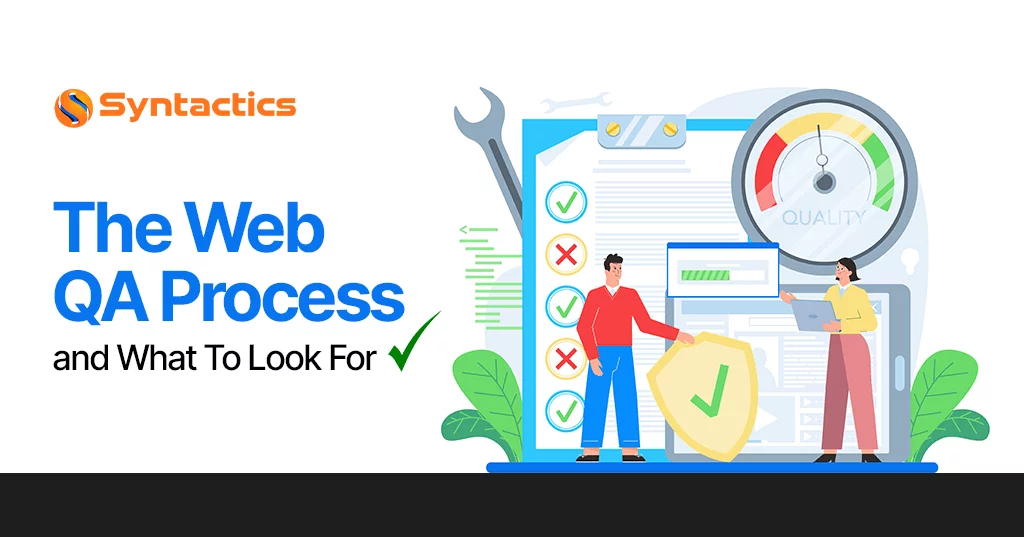
Harnessing the Power of User Acceptance Testing for Your Website
When a Quality Assurance or QA web tester examines your website’s performance, you’ll need to see how it looks to your end-users. In website development, User Acceptance Testing is the final phase of testing. Here, QA specialists examine the system’s functionality to see if it meets agreed-upon requirements and expectations.
Developers rely on end-users’ feedback during testing for the following:
- Validating the website design choices;
- Making necessary adjustments, and
- Enhancing User Experience (UX).

Source: WebFX.
These acceptance tests are critical for ensuring that your website resonates with target audiences. Let’s discuss UAT, its benefits, and its role in creating seamless website experiences.
What Is User Acceptance Testing?
UAT is a critical phase of website Quality Assurance testing where the QA team will see whether a system meets specific requirements. In addition, testers ensure that the project functions as intended, meets business needs, and is user-friendly.
Tests are designed to replicate real-world usage and simulate how users will interact with the website.
Objectives and Benefits of UAT
The primary objective of testing is to ensure that the website is appealing, performs well, and meets or exceeds user expectations. UAT is also one of the last steps that testers and developers go through before launching the website.
After all, Quality Assurance testing is necessary to find any potential errors and correct them to prevent future issues for end-users. UAT leads to the following benefits:
Assess and improve product quality
UAT supports a development team in assessing and resolving issues that can affect end-user experience.
Minimize cost
Taking UAT provides an easier and more affordable approach to resolving issues within the website and improving features during development.
Promotes brand image
UAT provides a consistent approach to ensuring the site is of an elevated quality, which contributes to improving the brand’s appeal and image.
Ensures compliance
Lastly, UAT tests help ensure that the site meets all requirements and regulations provided by the law. This ensures legal compliance.

Source: Zippia.
Key Stakeholders Involved in UAT
Tests involve several key stakeholders who play different roles in testing the website. Involved stakeholders include:
End Users
This refers to the target audience who will ultimately use the finalized website. They will utilize the website and provide feedback regarding the website and issues, ensuring the website meets user needs and expectations.
Business Analysts
Business analysts work alongside end users to understand their feedback and other needs within the website. The analysts will translate these findings into test cases that address all possible scenarios.
Quality Assurance Team (QA)
The QA team helps design the testing strategy and develop test cases during UAT. A web tester ensures that the website meets quality standards and prevent problems from occurring before its release.
Development Team
The development team addresses any issues that are identified during the initial testing phase. They will work with the QA team to make necessary changes that would resolve the issues and improve the website further.
Project Managers
These professionals oversee the UAT process. They ensure that the testing stays on schedule and within budget limits. They coordinate with other associated stakeholders that are involved in the testing process.
Executive Management
Executive management is responsible for keeping the website’s features aligned with the organization’s objectives. They also make critical decisions within the project if necessary.
Product Owner
The product owner represents the stakeholder’s interests. They define the website’s goals, its features, and purpose. They also provide necessary direction during UAT in keeping the website aligned with business goals.
Harnessing the Power of User Acceptance Testing for Your Website
Now that we understand UAT and its benefits, let’s explore how these tests benefit your website.
A QA tester will design test cases and utilize the best strategies to properly examine the project. As a result, they can ensure that your website performs well and exceeds audience expectations.
Planning and Preparation
Before starting a test, businesses need to define their goals and the scope of their web project. Within this phase, associated stakeholders should determine the important features that need to be tested and what outcomes they’re looking for.
Your objectives can include the following:
- Meeting user requirements;
- Identifying and addressing any issues or bugs;
- Validating user-friendly functionality.
A tester utilizes Quality Assurance tools to validate potential issues.
After defining the necessary objectives, the next step is to establish specific criteria within UAT. The criteria should be based on user requirements and factors for successful outcomes.
Next, QA specialists will design test cases with step-by-step instructions, which will serve as a guide for test execution later on.
The last step in this phase is to select the right participants for the User Acceptance Test. They should reflect your target audience or stakeholders who will potentially engage with your website. This approach is the closest thing to having actual users test out the final project.
Conducting UAT
Once everything has been planned out, it’s time to uncover what to expect during test execution. During testing, participants should follow a predefined case that simulates real-world usage. The associated test cases also cover various workflows that ensure the website’s intended behavior.
Throughout the testing phase, participants acting as end-users take note of important observations, which will be used as feedback.
User feedback provides valuable insights into:
- User satisfaction;
- Usability issues, and
- Any discrepancies between user expectations and the software’s performance.

Source: GoodFirms.
Addressing Defects and Iterative Testing
After the testing stage, your team should collect the provided feedback, analyze the results, and pinpoint common issues or defects. This analysis enables effective issue prioritization and resolution to meet desired website quality standards.
A dedicated web development team will employ the necessary methods to resolve these issues immediately.
Regression testing for websites is also critical to maintain the project’s stability and the latest changes don’t result in new issues. Automated testing tools can also be introduced to streamline the process.
Taking this approach consistently ensures the improvement of your website and addresses current concerns as much as possible.
Regression testing includes:
- Early defect detection;
- Process validation;
- User satisfaction, and
- Cost reduction.
This testing phase also ensures that your team spots any problems before the intended user can interact with the website.
According to Forbes Advisor’s Top Website Statistics For 2024, 88% of users won’t return to a site after a bad online experience. Should any issue be left unaddressed, your website’s reputation will be affected.
Integrating UAT Into the Development Lifecycle
The website development life cycle is a cost-effective process that web developers rely on when designing websites and applications. It involves minimizing project risks and meeting expectations during and beyond the production phase.
Testing is often integrated into both Agile and DevOp methodologies as part of the development life cycle. This iterative approach enables stakeholders to provide feedback on software increments, fostering collaboration between development teams and end-users.
Adopting the two methodologies also contributes to continuous improvement and alignment with user needs.
Additionally, for a successful cycle, consider efficient scheduling of UAT milestones. Project managers collaborate with stakeholders to set clear UAT entry and exit criteria. This ensures precise guidance on testing commencement and conclusion.
User Training and Adoption Strategies
User training and support is another integral component of any successful website launch.
Development teams offer general step-by-step training, tutorials, or documentation that website owners can rely on when managing the project. The provided sessions should be designed to match users of different skills and levels.
The web development team should base their findings on the initial test to provide comprehensive training sessions. Additionally, they should establish a support system via help desks or online forums to assist users with challenges or issues encountered during use.

Source: FinancesOnline.
To encourage users’ smooth adoption of new website features, it’s crucial to communicate the benefits and value of these additions. Businesses can accomplish this through targeted marketing campaigns, informative emails, or in-app notifications.
Overcoming Challenges and Best Practices
Even though UAT provides websites with significant benefits, it’s not free of challenges. These tests often encounter several obstacles, such as:
- Resource constraints;
- Budget limitations;
- Unmet stakeholder expectations, and
- Stakeholder resistance.
Developers and QA testers should be able to skillfully handle these matters by adopting various best practices.
For instance, one helpful practice is onboarding cross-functional teams. In addition, the team can focus on high-impact functionalities first before focusing on resources and budget matters.
Lastly, maintaining open communication channels with stakeholders is crucial for addressing resource limitations and facilitating creative problem-solving approaches.
Future Trends and Innovations
Designers and testers may also keep track of upcoming web design trends for future project development strategies. Here are some potential trends and innovations that will have a major impact on UAT:
Integrating AI and Machine Learning for Automated Testing.
One major trend for UAT is utilizing Artificial Intelligence and Machine Learning technologies during the development process. These technologies accelerate the testing and enable quick approaches to detecting and addressing potential issues.
Adoption of Cloud-based UAT Environments.
Cloud-based UAT environments are starting to gain popularity due to their flexibility and cost-effectiveness. By adopting cloud-based UAT environments, organizations can have more access to on-demand resources and provide better collaborative efforts among team members.
Refine Your Site Today
User Acceptance Testing plays a role in shaping how websites perform and ensuring they thrive within the online landscape. UAT is becoming increasingly vital as websites become more complex and user-centric, so a web Quality Assurance tester must identify usability issues and functionality gaps.
User Acceptance Tests can significantly help business owners achieve their goal of improving website performance as a whole. QA web testers help greatly in assessing the quality and performance of your website right before launch.
Frequently Asked Questions About UAT
What is the difference between UAT and QA?
User Acceptance Testing ensures that websites or software meet the needs of end-users prior to deployment. It involves real users and real-world environments. Quality Assurance testing aims to verify whether the website or software is bug-free while meeting requirements and standards throughout the development process.
What is another name for UAT testing?
Another name for UAT is end-user testing. It can even be referred to as beta testing.
What is QA in testing?
Quality Assurance in website or software development is a process that examines the product’s quality, reliability, and performance to ensure that the end product adheres to established expectations or standards.

















Comment 0